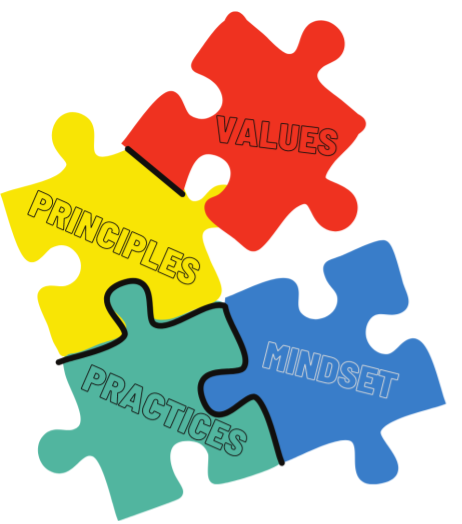Nowadays agile methodology has become extremely popular at takes leading positions among others like Waterfall, Scrum, Feature-Driven Development, Extreme Programming (XP), Nexus, and Lean.
This nice Agile adventure started at the very beginning of the century. In this post we’ll review the Agile Manifesto; the Agile Values and Principles described there; the Agile Mindset and Best Practices that will help you to improve the performance of your team.
Agile Values and Principles, according to the Agile Manifesto

In 2001, a group of authors published the document called Manifesto for Agile Software Development. The work described 4 values and 12 agile principles.
Agile Values
According to the Agile Manifesto, you can deliver development products better if you value:
Individuals and interactions over processes and tools Working software over comprehensive documentation
Customer collaboration over contract negotiation Responding to change over following a plan
That is, while there is value in the items on the right, we value the items on the left more.
Agile Values, according to the Manifesto for Agile Software Development
Value Individuals and Interactions over Processes and Tools
Teams should be empowered to work together efficiently, communicating effectively and utilizing their individual skill sets to reach their goals within the Agile environment. Ultimately, it is the team dynamic that is more valuable than any processes or tools they use.
Value Working Software over Comprehensive Documentation
Agile software development provides a shift from the traditional approach of creating extensive documentation prior to building software. Agile values early delivery of working software to customers in order to receive feedback quickly and make improvements accordingly. This process helps ensure that the customer receives the best value out of the software and can focus on how it can be used more effectively. Agile is an effective way to deliver working software, rather than documentation, in a timely manner.
Value Customer Collaboration over Negotiation
Customer collaboration allows for a finer degree of customization and feedback on deliverables. This creates a customer-centric approach that results in more effective and valuable solutions. Emphasizing high-level goals in contracts instead of detailed lists of requirements helps to streamline the change-management process and reduce room for misunderstandings.
Value Responding to Change over Following a Plan
Agile values emphasize responding to change and the importance of regular evaluation and retooling based on new information. Product roadmaps should not be viewed as static documents but as dynamic strategies that allow teams to adjust their priorities and plans accordingly.
This is done by committing and delivering in small, incremental iterations, an approach that enables teams to easily incorporate changes into their backlog. Relative size estimates are then used to quickly estimate sprint velocity and determine how many sprints are needed to complete a set of features.
Agile Principles
Principle I
Our highest priority is to satisfy the customer
through early and continuous delivery
of valuable software.
Manifesto for Agile Software Development, 2001
Principle II
Welcome changing requirements, even late in development. Agile processes harness change for the customer’s competitive advantage
Manifesto for Agile Software Development, 2001
Principle III
Deliver working software frequently, from a couple of weeks to a couple of months, with a preference to the shorter timescale
Manifesto for Agile Software Development, 2001
Principle IV
Business people and developers must work together daily throughout the project
Manifesto for Agile Software Development, 2001
Principle V
Build projects around motivated individuals. Give them the environment and support they need, and trust them to get the job done
Manifesto for Agile Software Development, 2001
Principle VI
The most efficient and effective method of conveying information to and within a development team is face-to-face conversation
Manifesto for Agile Software Development, 2001
Principle VII
Working software is the primary measure of progress
Manifesto for Agile Software Development, 2001
Principle VIII
Agile processes promote sustainable development. The sponsors, developers, and users should be able to maintain a constant pace indefinitely
Manifesto for Agile Software Development, 2001
Principle IX
Continuous attention to technical excellence and good design enhances agility
Manifesto for Agile Software Development, 2001
Principle X
Simplicity–the art of maximizing the amount of work not done–is essential
Manifesto for Agile Software Development, 2001
Principle XI
The best architectures, requirements, and designs emerge from self-organizing teams
Manifesto for Agile Software Development, 2001
Principle XII
At regular intervals, the team reflects on how to become more effective, then tunes and adjusts its behavior accordingly
Manifesto for Agile Software Development, 2001
The Agile Mindset and Practices

Agile Mindset
The Agile mindset is a way of thinking that a team must have to support Agile Practices. In general, Agile puts customers first and emphasizes the importance of delivering customer value through constant experimentation. This helps to build trust in the team and encourages them to be independent, creative, and innovative. It is this foundation that empowers average teams to become high-performing Agile teams.
Put Customers First
The Agile Mindset puts customers first, striving to deliver value and create an optimal customer experience. This focus on understanding the customer perspective ensures that everyone in a team is aligned and understands what the goal is and why it is important to prioritize it. By taking this approach, teams are able to create more meaningful products and services that delight customers.
Trust in the Team
Team members with an Agile Mindset understand the value of autonomy and independence when it comes to completing tasks and projects. They are capable of working autonomously and managing their own workloads, which leads to increased productivity. Working in this way means there is less need for direct supervision, as they have the skills, knowledge, and motivation to stay on track and complete their work efficiently. This type of mindset is invaluable in today’s modern workplace where siloed departments and processes are no longer effective.
Consequently, having an agile mindset adds tremendous value to the team because it provides team members with the ability to experiment and innovate. Moreover, it creates a self-managed environment that allows them to act independently, take control of their projects and get the job done with little need for direct supervision.
Emphasize Experimentation
Having an agile mindset helps fuel creativity and encourages experimentation. Taking risks is a major part of engaging in experimentation, but it can lead to unique solutions that may not have been available beforehand. This way of thinking allows team members to search for opportunities to innovate and push the boundaries, leading to valuable outcomes.
Agile Practices

Agile techniques and practices are the cornerstones of any successful project, as they provide the framework and guidance to help teams work collaboratively and iteratively toward a common goal. Ultimately, understanding how to implement Agile practices will help improve communication and collaboration, and ensure successful project delivery.
Scrum
When it comes to practices, agile frameworks come up. Scrum is one of them.
Scrum is a powerful and highly effective framework that helps teams apply the agile mindset to their work. It encourages collaboration between team members, promotes continuous improvement, and encourages self-organization. As such, Scrum is an invaluable tool for embracing the agile mindset and transforming our work.
The Product Owner has a key role in the Scrum process as they are responsible for
- communicating with stakeholders and maintaining the product backlog
- maximizing the value of the product resulting from the work done by the Scrum team
Consequently, it is essential for a Scrum team to have a competent PO who can effectively manage both sides of the project: business and development.
The Scrum framework is designed to help teams work efficiently and effectively, with each Sprint serving as a mini-goal in the long-term project plan. During the Daily Scrums, team members can ensure their individual tasks are on track to meet the overall Sprint goal. Additionally, the other events that occur during each Sprint provide an opportunity to review progress and adjust goals as necessary.
This iterative and flexible workflow is why Scrum is such an effective approach for teams of all sizes and supports the best practices for Agile.
Best Practices For Agile
- The product backlog should be regularly updated and prioritized with the team
- A business roadmap should be created and aligned with the product backlog
- Sprint reviews should be held on a regular basis
- Product Owner should give positive or negative feedback after each review
- Involve the whole team in reprioritizing the backlog based on the PO feedback
Agile or Waterfall?
In Contrast to Agile, the Waterfall practice is not tolerant of changes and assumes a long-term up-front planning and development process where the project is split into stages going one after another. The customer sees the result only at the end of the project.
- The project has a very small scope
- The speed of delivery is not very important
- The project requirements and demand are not likely to change
Recap
4 Agile Values
- Individuals and interactions over processes and tools
- Working software over comprehensive documentation
- Customer collaboration over contract negotiation
- Responding to change over following a plan
12 Agile Principles
- Early and continuous delivery of valuable software
- Welcome changing requirements, even late in development
- Deliver working software frequently
- Business people and developers must work together daily throughout the project
- Build projects around motivated individuals
- Face-to-face conversation
- Working software is the primary measure of progress
- Promote sustainable development
- Continuous attention to technical excellence and good design
- Simplicity is essential
- Self-organizing teams
- At regular intervals, the team reflects on how to become more effective, then tunes and adjusts its behavior accordingly
If you still have questions with regard to the Agile Principles and Values or how to introduce them into your development cycle, feel free to Connect With Us.

As someone who has worked in both traditional and agile environments, I can attest to the power of an agile mindset. Have you had any experiences transitioning from a traditional approach to agile?
What was your biggest takeaway?